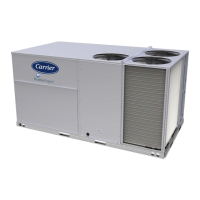16
When space temperature sensor control in enabled (UNIT CON-
TROL TYPE), the unit will try to maintain the Space Tempera-
ture (SPACE TEMPERATURE) between the effective cool and
heat setpoints (EFF COOL SETPOINT and EFF HEAT SET-
POINT). However, to minimize unnecessary cool to heat and
heat to cool changes, there is a 10 minute delay after the last
stage turns off before the control will switch modes. Linkage op-
eration overrides the mode changeover delay to 15 seconds. The
cooling and heating Mode Select Time guards (COOL MODE
T.GUARD and HEAT MODE T.GUARD) show the remaining
time before allowing the respective mode to be entered.
Demand Determination
Based on the unit control type (UNIT CONTROL TYPE), alarm
conditions, and user interaction, the control will determine an
overall demand of the unit. Table 9 shows the possible system
demands with their priority level and summary description.
THERMOSTAT DEMAND
When the unit control type is configured for thermostat (UNIT
CONTROL TYPE = TSTAT) the level 5 demand in Table 9
will be determined by thermostat inputs and the Thermostat
Type configuration (THERMOSTAT TYPE) as shown in the
tables below. Table 10 shows the cooling thermostat inputs and
how they map to the system demand. Table 11 shows the heat-
ing thermostat inputs and how they map to the system demand.
Table 8 — Modes and Sub-Modes
MODE OFF VENT COOL HEAT TEST
SUBMODES
STARTING UP MODE TIMEGUARD ECON FREE COOLING HEATING MANUAL TEST
IDLE - NO DEMAND SUPPLY FAN ON UNOCC. FREE COOL
OUTSIDE AIR
TEMPERING
AUTO TEST
MODE TIMEGUARD MECH. COOLING HEATING PREVENTED SHUTTING TEST OFF
UNIT DISABLED ECON/MECH COOLING SHUTTING HEAT OFF
URGENT SHUTDOWN DEHUMIDIFICATION
SAFETY CONTROL DEHUM/MECH COOL
DEHUM PREVENTED
COOLING PREVENTED
SHUTTING COOL OFF
Table 9 — Demand List and Priority
DEMAND PRIORITY DESCRIPTION
EMERGENCY 1 An emergency condition occurs which requires a unit shutdown
SAFETY FAULT 2 A safety diagnostic requires the unit to run in safety mode
SERVICE TEST 3 User request test mode
SHUTDOWN 4 A minor or user condition requires the unit to shutdown
NO DEMAND
5
There is no comfort demand from the building
FAN ONLY Only circulation or ventilation is requested from the building
DEHUM A dehumidification load is present in the building
LOW COOL A low cooling load is present in the building
MED COOL A medium cooling load is present in the building
HIGH COOL A high cooling load is present in the building
LOW COOL AND DEHUM A low cooling and dehumidification load is present in the building
MED COOL AND DEHUM A medium cooling and dehumidification load is present in the building
HIGH COOL AND DEHUM A high cooling and dehumidification load is present in the building
UFC LOW COOL A low cooling load is present in the building due to the unoccupied free cooling algorithm
UFC MED COOL A medium cooling load is present in the building due to the unoccupied free cooling algorithm
UFC HIGH COOL A high cooling load is present in the building due to the unoccupied free cooling algorithm
LOW HEAT A low heating load is present in the building
HIGH HEAT A high heating load is present in the building
SUPPLY AIR TEMPERING Due to outside air, supply air is uncomfortably cool during ventilation
Table 10 — Thermostat Cooling System Demands
THERMOSTAT INPUTS THERMOSTAT TYPE
Y1 Y2 Y3 CONV 2C2H* CONV 3C2H DIGI 2C2H† DIGI 3C2H
0 0 0 No Cool No Cool No Cool No Cool
0 0 1 No Cool Alert and Low Cool No Cool High Cool
0 1 0 Alert and Low Cool Alert and Low Cool Medium Cool Medium Cool
0 1 1 Alert and Low Cool Alert and Medium Cool Medium Cool High Cool
1 0 0 Low Cool Low Low Cool Low Cool
1 0 1 Low Cool Alert and Medium Cool Low Cool High Cool
1 1 0 High Cool Medium Cool High Cool Medium Cool
1 1 1 High Cool High Cool High Cool High Cool
*Set the LOW COOL COMP as needed, and Y3 is ignored.
†Y3 is ignored.

